Restorative Dentistry
Dental Fillings
Dental fillings are a common restorative procedure in dentistry used to repair and restore teeth damaged by decay, fractures, or wear. They help preserve tooth function, prevent further damage, and maintain oral health.
Purpose of Dental Fillings
Repair cavities: Fillings restore the damaged structure caused by tooth decay.
Fix cracks or fractures: Restore the integrity of broken or chipped teeth.
Prevent further decay: Seal off areas where bacteria could enter.
Restore functionality: Reinstate normal chewing and biting capabilities.
Types of Dental Fillings
The choice of filling material depends on the tooth's location, aesthetic needs, and budget. Common types include:
1. Composite Resin Fillings:
Material: Tooth-colored resin made from a blend of plastic and fine glass particles.
Pros: Matches natural tooth color, bonds directly to the tooth, good for front teeth.
Cons: Less durable than amalgam (5–10 years), higher cost.
2. Glass Ionomer Fillings:
Material: A mix of acrylic and glass.
Pros: Releases fluoride to help prevent further decay, good for baby teeth or near the gumline.
Cons: Less durable and prone to wear, typically used in less load-bearing areas.
3. Temporary Fillings:
Purpose: Used as a short-term solution in cases of emergency or before further treatment.
Cons: Not as strong; intended to last only a few weeks.
Procedure for Dental Fillings
1. Diagnosis: X-rays and examination to assess the tooth's condition.
2. Anesthesia: Local anesthesia is administered to numb the area.
3. Preparation: Decay or damaged areas are removed, and the cavity is cleaned.
4. Filling Placement:
Material is layered into the cavity. Each layer is hardened (cured) with UV light, if applicable.
5. Shaping and Polishing: The filling is shaped to match the natural bite and polished for smoothness.
Care for Dental Fillings
Maintain good oral hygiene (brush twice daily and floss).
Avoid biting hard objects to prevent cracking.
Regular dental check-ups to monitor the condition of the filling.
Replace fillings when they wear out or if new decay occurs around them.
Dental fillings are essential for preserving tooth structure, preventing complications, and maintaining a healthy smile.
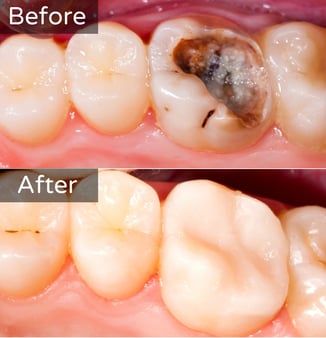

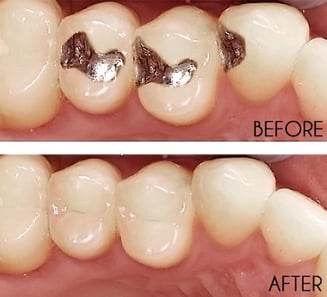

Crowns and Bridges
Crowns and bridges are dental restorations designed to restore the function, appearance, and structure of damaged or missing teeth. They are essential for maintaining oral health, improving aesthetics, and enhancing chewing and speech
1. Dental Crowns
A crown is a cap placed over a damaged, decayed, or weakened tooth to restore its size, shape, and strength.
Uses of Crowns:
Protect weak or cracked teeth.
Restore a broken or severely worn-down tooth.
Cover a tooth with a large filling.
Hold a dental bridge in place.
Cover a dental implant or discolored/misshapen teeth.
After a root canal treatment to protect the tooth.
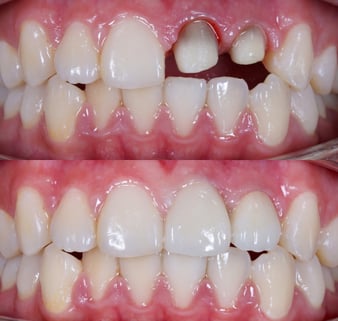

Materials for Crowns:
1. Metal Crowns: Durable, made of gold, platinum, or other metal alloys.
Pros: Long-lasting, resistant to wear.
Cons: Metallic color, used mostly for molars.
2. Porcelain-Fused-to-Metal (PFM) Crowns:
Pros: Strong, blends with natural teeth.
Cons: Metal edge may be visible over time.
3. All-Ceramic or All-Porcelain Crowns:
Pros: Best for aesthetics, natural appearance.
Cons: Less durable than metal crowns, can chip.
4. Zirconia Crowns: Made of zirconium dioxide.
Pros: Extremely strong, aesthetic, biocompatible.
Cons: Higher cost.
5. Resin Crowns: Affordable but less durable.
Pros: Cost-effective.
Cons: Wears down quickly, prone to fractures.
Dental Bridges
A dental bridge replaces one or more missing teeth by anchoring artificial teeth (pontics) to adjacent natural teeth or implants.
Types of Bridges:
1. Traditional Bridge:
Uses crowns on adjacent teeth to hold the pontic. Best for teeth surrounded by healthy natural teeth.
2. Cantilever Bridge:
Anchored to only one adjacent tooth. Used when there’s only one supporting tooth available.
3. Maryland Bridge:
A pontic with wings bonded to the backs of adjacent teeth. Minimally invasive but less durable.
4. Implant-Supported Bridge:
Supported by dental implants rather than natural teeth. Highly stable and durable, used for multiple missing teeth.
Materials for Bridges:
1. Preparation:
For crowns, the tooth is reshaped. For bridges, the adjacent teeth are prepared.
2. Impressions: Digital scans or molds are taken to create a custom fit.
3. Temporary Placement: A temporary crown or bridge is placed while the permanent one is made.
4. Final Placement: The permanent restoration is cemented or bonded in place.
Benefits:
Restores chewing and speaking ability. Prevents adjacent teeth from shifting. Enhances aesthetics and smile confidence. Protects damaged teeth from further decay or fracture.
Care and Maintenance:
Brush and floss daily, especially around the bridge or crown.
Avoid biting on hard objects (e.g., ice, hard candies).
Use a fluoride toothpaste to prevent decay.
Regular dental check-ups for cleaning and inspection.
Crowns and bridges are durable, lasting 5–15 years or more with proper care, making them a reliable solution for restoring dental function and aesthetics.


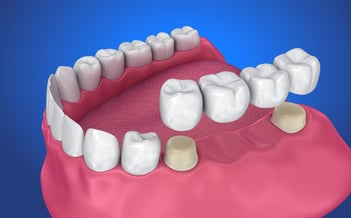





Root Canal treatment
A root canal is a dental procedure used to treat infection or damage within the pulp (the soft tissue inside the tooth that contains nerves, blood vessels, and connective tissue). The goal of a root canal is to save a tooth that would otherwise need to be extracted, relieving pain and preventing the spread of infection
When is a Root Canal Needed?
A root canal is necessary when the pulp becomes infected or inflamed, which can occur due to:
Deep cavities or decay that reach the pulp. Trauma or injury to the tooth, causing cracks or fractures. Repeated dental procedures on the tooth. Severe gum disease that spreads to the pulp. Signs that a root canal may be needed include: Severe toothache, especially when chewing or applying pressure. Sensitivity to hot or cold that lingers after the stimulus is removed. Swelling or tenderness around the tooth. Discoloration (darkening) of the tooth. A pimple-like bump on the gums (abscess).


Procedure for a Root Canal
1. Diagnosis: X-rays or tests to confirm the infection or damage to the pulp.
2. Anesthesia: Local anesthesia is administered to numb the affected tooth and surrounding area.
3. Access Opening: The dentist drills a small hole in the tooth to access the pulp chamber.
4. Cleaning the Canal: The infected or damaged pulp is removed. The inside of the tooth is cleaned, shaped, and disinfected.
5. Filling the Canal: After cleaning, the root canal is filled with a biocompatible material (usually gutta-percha) to seal it and prevent re-infection.
6. Restoration: The tooth is typically sealed with a temporary filling, followed by a permanent restoration, such as a crown, to restore the tooth's function and appearance.
Post-Procedure Care
Pain management: Some discomfort or mild pain is normal after a root canal, usually lasting a few days.
Medications: Over-the-counter pain relievers, or in some cases, antibiotics if there is an infection.
Follow-up: A follow-up visit may be required to check the healing and the permanent restoration.
Benefits of a Root Canal
Saves the Tooth: The primary benefit is that the tooth is preserved, avoiding extraction.
Pain Relief: The procedure removes the infection and inflammation, relieving pain caused by an abscess or nerve damage.
Prevents Infection Spread: By sealing the tooth, a root canal prevents the infection from spreading to surrounding tissues.
Long-Lasting: With proper care, a tooth that has undergone a root canal can last many years, sometimes for life.
Risks and Considerations
Infection Recurrence: In rare cases, the infection may recur if the root canal is not fully cleaned or sealed.
Tooth Fracture: Teeth that undergo root canals can become more brittle over time, which is why a crown is often recommended.
Cost: Root canals can be more expensive than other treatments, but they are often more cost-effective than extraction and replacement.
Alternative to Root Canal
If a root canal is not performed, the affected tooth may need to be extracted. A replacement, such as a dental implant, bridge, or partial denture, would then be required. A root canal is a highly effective procedure that helps save teeth, alleviate pain, and restore function, making it a common and essential part of modern dental care.


Dentures (Complete and Partial)
Dentures are custom-made removable prosthetic devices designed to replace missing teeth and restore oral functionality and aesthetics. They are a common solution for patients who have lost some or all of their natural teeth due to injury, decay, or periodontal disease.
Types of Dentures
1. Complete Dentures:
Replace all teeth in either the upper or lower jaw. Rest on the gums and are held in place by suction or adhesive.
2. Partial Dentures:
Replace one or more missing teeth while some natural teeth remain.
Typically attached to natural teeth using metal clasps or precision attachments.
3. Implant-Supported Dentures:
Anchored to dental implants fixed into the jawbone. Provide better stability and comfort compared to conventional dentures.
4. Immediate Dentures:
Placed immediately after tooth extraction. Act as a temporary solution while gums heal and permanent dentures are prepared.
5. Overdentures:
Fit over existing teeth or implants. Provide additional support and prevent bone loss.
Materials Used in Dentures
1. Acrylic Resin:
Lightweight and affordable. Commonly used for both bases and artificial teeth.
2. Metal (Cobalt-Chromium):
Used in partial dentures for strength and durability. Thinner and more comfortable than acrylic bases.
3. Porcelain:
Used for artificial teeth to provide a natural appearance. Durable but can be heavy and prone to chipping.
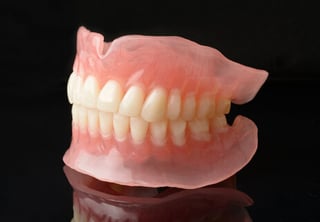

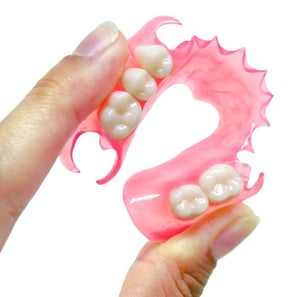

Complete Denture
Partial Denture
4. Flexible Resin:
Used in flexible partial dentures. Provides better comfort and aesthetics.
Steps in Making Dentures
1. Consultation and Diagnosis:
Examination of oral health and assessment of the need for dentures.
2. Impressions:
Molds of the patient’s oral structures are taken.
3. Wax Models:
Trial dentures made to check fit, alignment, and aesthetics.
4. Fabrication:
Dentures are crafted using selected materials.
5. Fitting and Adjustments:
Final dentures are fitted, and adjustments are made for comfort.
Care and Maintenance
Daily Cleaning:
Remove and brush dentures with a soft denture brush using mild soap or denture cleaner. Rinse with water to remove food particles and plaque.
Overnight Soaking:
Store dentures in water or a denture-cleaning solution to prevent drying out.
Regular Dental Checkups:
Ensure proper fit and check for any wear, damage, or oral health issues.
Handle with Care:
Avoid dropping dentures to prevent cracking or breaking.
Advantages of Dentures
Restore chewing and speaking ability. Improve facial aesthetics by preventing sagging.Boost self-confidence by replacing missing teeth. Economical compared to other restorative options like implants.
Limitations of Dentures
Require regular adjustments as gums and bone structure change over time. May initially cause discomfort or difficulty in speaking. Less stable compared to fixed prosthetics like implants. Risk of breakage or wear over time.
